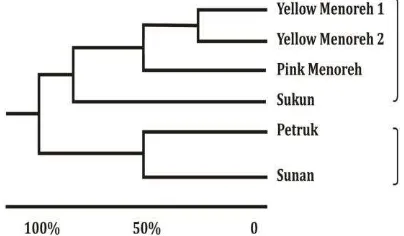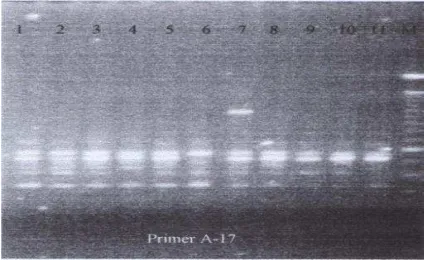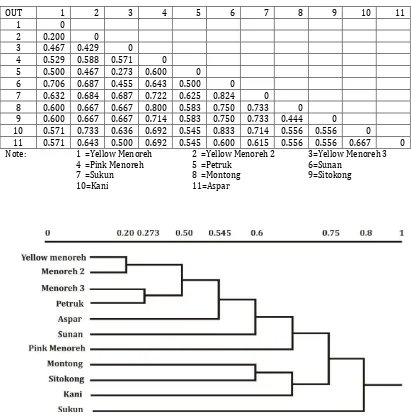27
RESEARCH
Identification and Classification of Pink Menoreh Durian
(
Durio Zibetinus
Murr.) Based on Morphology and Molecular
Markers
Nandariyah
a,b*
aDepartment of Agronomy, Faculty of Agriculture, Sebelas Maret University, Jl. Ir. Sutami 36 A, Surakarta 57126,
Indonesia
bCenter of Biotechnology and Biodiversity Research and Development, Sebelas Maret University, Jl. Ir. Sutami 36A,
Surakarta 57126, Indonesia
Received: 11 January 2011 Accepted: 28 March 2011
Abstract
Durian is an exotice fruit from Kulon Progo Specific Distric Yogyakarta Province Indonesia. Research aimed was to obtain an identity and classification of Menoreh durian based on its morphology and molecular markers in order to propose it as a new superior variety. Seventy four morphology characters of Pink Menoreh durian were studied (stem, leaf, flower, fruit and seed characters) compared with that of Petruk, Sunan, Sukun, and Yellow Menoreh durian. PCR-RAPD was done for molecular analysis. Classification of durian cultivars based on morphology characters was resulted two groups of durian: group one (consisted of Menoreh and Sukun durian) and group two (consisted of Petruk and Sunan durian). There were three group of durian based on molecular characters: First group (Yellow Menoreh, Petruk, Aspar, Sunan and Pink Menoreh durian), Group two (Montong, Sitokong and Kani durian), and Group three (Sukun durian). Pink Menoreh durian was shown as a variety by molecular analysis.
Key words: Pink Menoreh Durian, Durio Zibetinus Murr.
INTRODUCTION
Menoreh durian is an important commodity and superior fruit from Kulon Progo Regency Specific Regency Province Yogyakarta. The superiority of the durian fruit is in its delicious taste and thickness of flesh. There are two varieties of superior durian from Kulon Progo: The Yellow Menoreh and The Pink Menoreh durian. The specific color of Pink Menoreh durian is the pink color of flesh. In order to obtain the decision of Menoreh durian as new superior variety the identification and classification of the durian must be carry out. Since it is difficult to find out the distinction between the durian variations based on morphology characters only, we also used the molecular method for identification. Molecular identification method with RAPD was used to obtain the plant
identification because the method has no environment effect influence. The research aimed was to obtain the molecular identity of Menoreh durian variety and its classification in order to find decision of its superiority as a new variety. The decision of Menoreh durian adds nationally varieties that can be declare of the biodiversity identity of locally Kulon Progo Regency.
MATERIALS AND METHODS
Research carry out with morphology characters data analysis of Pink and Yellow Menoreh
Correspondence Author: * Nandariyah
Department of Agronomy, Faculty of Agriculture, Sebelas Maret University, Jl. Ir. Sutami 36 A, Surakarta 57126
Menoreh durian plants in village of Slanden, Banjaroyo, Kalibawang, Regency of Kulon Progo. Seventy four characters collected from stem, leaf, flower, fruit and seed were compared with that of Petruk, Sukun, and Sunan durian planted in Karanganyar Central Java. Similarity index matrix among the cultivars resulted of morphology data with Jaccard method (1) followed by dendogram
analysis. Molecular identification and classification of Menoreh durian with PCR-RAPD method was carried out in our laboratory. Material for research was 11 axesion of durian consisted of: Yellow Menoreh (1, 2, and 3), Pink Menoreh, Petruk, Sunan, Sukun, Montong, Sitokong, Kani, and Aspar durian. The research was carried out of as follow: (1) DNA extraction, (2) quantity and quality DNA test, (3) DNA amplification, (4) electrophoresis, (5) DNA visualization, and (6) DNA result analysis.
The DNA extraction method for Salak was used for durian DNA extraction (2). A 150 mg of
young leaf durian was grinded with mortar followed with addition of 1,000 μl of CTAB solution and centrifugation at 13,000 rpm for 5 minutes. Supernatant (in green color) was separated and then incubated at 65 °C. After 1 hour the solution was added with 800 l of chloroform and centrifuged at 13,000 rpm for 7 minutes. The supernatant was then placed in the eppendorf tube and precipitated with 20 l of Na Acetate (pH 7.5) and 650 l of Isopropanol, followed by centrifugation at 13,000 rpm for 7 minutes. The DNA pellet was then separated from the solution, added with 70 % of cold ethanol and centrifuged at 13,000 rpm for 5 minutes. DNA pellet was dried for 2 hours, resolved in Tris EDTA sterile solution and store at 4 °C. DNA amplification process (PCR-RAPD) was used 18 single primers of Operon Alameda: OPA-1 - OPA-18.
RESULTS AND DISCUSSION
A. Identification and classification based on plant morphology characters arranged as a matrix as described in Table 1.
Table 1. Similarity index value of Durian Pink Menoreh and others. lowest and highest similarity, respectively. Low similarity index showed the highest Menoreh durian is a new variety. Based on the similarity index value matrix, the dendogram could be arranged used the Un-weighted Pair-Group Method Using Arithmetic Average (UPGMA).
Classification of durian cultivars based on the morphology characters in the dendogram resulting two groups: group I (Menoreh 1, Menoreh 2 and Sukun) and group II (Petruk and Sunan). The Pink Menoreh durian had a 63.51 % distinction with that of Yellow Menoreh durian. These findings support the previous report (3) that Pink Menoreh durian is
standing as a variety.
Figure 1. Dendogram classification of durian based on
29 B. Identification and classification of
durian based on molecular analysis (PCR-RAPD)
Molecular analysis with RAPD technique used 18 single primers resulted 10 primers that showed DNA polymorphism and clear bands. Amplification DNA with primer of OPA-1 showed three patterns of polymorphism bands (Figure. 2)
Figure 2. The RAPD results with OPA-1 and OPA-2
primers.
Figure 3. The RAPD results with OPA-13 primer.
Figure 4. The RAPD results with OPA-17 primer.
Amplification with OPA-2 showed more variations (band number 1-6 consisted 7 patterns). Menoreh 3 was differing with that
of Menoreh 1 and Menoreh 2 at 300 and 380 base pairs of PCR products. DNA of Sukun durian showed differences of bands pattern at 250, 300 and 380 base pairs; and the 2,000 bp band was only showed in Sukun cultivar. Amplification of DNA durian with OPA-13 primer resulted clear bands.
Amplification of DNA resulted 3 patterns: I. The two bands pattern: Sitokong and Kani durians originally from Thailand (number 9 and 10, respectively); II. The three bands pattern: Yellow Menoreh durian (number 1, 2, and 3), Petruk, Sunan, Sukun, Montong and Aspar durian (number 5, 6, 7, 8, and 11, respectively); III. The four bands pattern: Pink Menoreh durian. Pink Menoreh DNA (number 4) had different pattern with others via 250 bp of PCR products. DNA amplification with OPA-17 primer showed different pattern with that of the Sukun durian (number 7) as shown with 500 and 1050 bp of PCR products. Also, using OPA-19 primer, the Sukun DNA consisted of 5 bands comparing with the others (2 or 3 bands). Salak DNA amplification with 6 primers (OPA-11, OPA-16, OPA-17, OPA-18, OPX-15 and OPX-17) was resulted 3-6 polymorphic bands with 250-3000 bp PCR products (2). Using RAPD for genetic diversity
study of coconut cultivars was resulted 250-3080 bp (4). Short primer (10-mer) in general
can amplify DNA sequent less than 4,000 bp. The DNA amplification with OPA-4 primer (number 4) showed the differentiation of the Pink Menoreh DNA with the others in 490 bp of PCR products. DNA amplification with OPA-18 resulted different bands with the others at via 400 and 480 bp of PCR products.
The Yellow Menoreh 1 and Yellow Menoreh 2 had the lowest distinct therefore the may originated from same parent (Table 2). Yellow and Pink Menoreh durian was durian originated from Kulon Progo Regency. The genetic difference among cultivars than was analyzed using the Jaccard method (1).
Genetic distinct between Pink Menoreh and Yellow Menoreh was between 0.529-0.588. The genetic distinct more than 20 % supported the position of one accession differ with other variety (3). The genetic distinct
durian cultivars were grouped within three groups: the first group (consisted of Menoreh, Petruk, Aspar, Sunan and Pink Menoreh durian), the second group (consisted of Montong, Sitokong, and Kani durian originally
from Thailand), and the third group consisted of the Sukun variety. As shown in the dendogram, the Pink Menoreh durian was
showed as a variety.
Figure 5. The RAPD results with OPA-4, OPA-18 and OPA-19, respectively.
Table 2. Genetic distance matrix of the Durians.
OUT 1 2 3 4 5 6 7 8 9 10 11
1 0
2 0.200 0
3 0.467 0.429 0
4 0.529 0.588 0.571 0
5 0.500 0.467 0.273 0.600 0
6 0.706 0.687 0.455 0.643 0.500 0
7 0.632 0.684 0.687 0.722 0.625 0.824 0
8 0.600 0.667 0.667 0.800 0.583 0.750 0.733 0
9 0.600 0.667 0.667 0.714 0.583 0.750 0.733 0.444 0
10 0.571 0.733 0.636 0.692 0.545 0.833 0.714 0.556 0.556 0
11 0.571 0.643 0.500 0.692 0.545 0.600 0.615 0.556 0.556 0.667 0
Note: 1 =Yellow Menoreh 2 =Yellow Menoreh 2 3=Yellow Menoreh 3
4 =Pink Menoreh 5 =Petruk 6=Sunan
7 =Sukun 8 =Montong 9=Sitokong
10=Kani 11=Aspar
31 ACKNOWLEDGMENT
We would like to thank to the Head of Agriculture Department of Kulon Progo for this research project funding, and the Ministry of Agriculture Indonesia that supports the Pink Menoreh durian as a new nationally superior variety originally from Kulon Progo.
REFERENCES
1. Lengkong, E. F. 1998. Genetics variability of three cultivars Coconut based on molecular markers. Random Amplified Polymorphic DNA (RAPD). Tesis Program of S2 Institut Agriculturen Bogor.
2. Mulyaningsih, B. 2004. Genetic variability vector dengue Aedes albopictus skuse (Diptera: Culicidae) and its responce against malation and temefos. Thesis. S3 University of Gadjah Mada Yogyakarta.
3. Nandariyah. 2007. Variability study of cultivar Salak of Java based on morphology and RAPD markers. Thesis. S3. University of Gadjah Mada Yogyakarta.
4. Newbury, H. J., Ford-Lloyd, B. V. 1993. The used of RAPD for assessing variation in plants. Plant Growth Regulation12: 43-51.
5. Shiraishi, S., Watanabe, A. 1995. Identification of chloroplast genome between Pinusa
densiflora. SIEB, et ZUCC and P. Thunbergii
PARL. Based on the polymorphism in rbl gene. Journal of the Physical Society of Japan. 77: 429 – 436.
6. Singh, R. K., Chaudary, B. D. 1979. Biometrical methods in quantitative genetic analysis. Kalyani Publishers, Ludhiana, New Delhi. 7. Sneath, P. H., Sokal, H. R. 1973. Numerical


